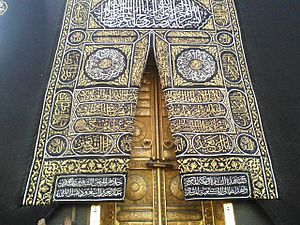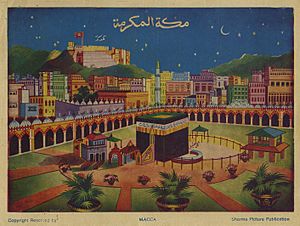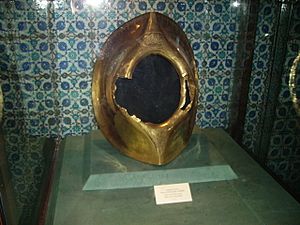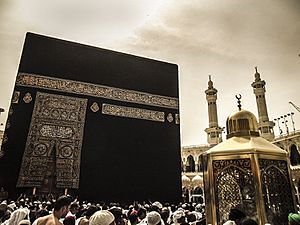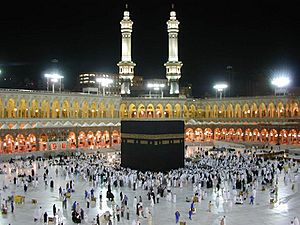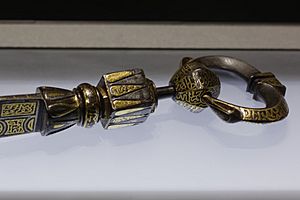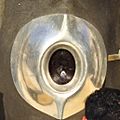Kaaba facts for kids
Quick facts for kids Kaaba (Kaʿbah) |
|
|---|---|
|
أَلكَعْبَة
|
|
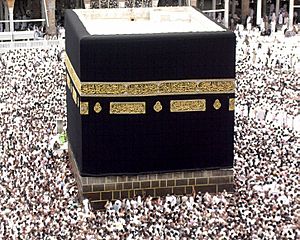
The Kaaba surrounded by pilgrims
|
|
| Religion | |
| Affiliation | Islam |
| Location | |
| Location | Holy Mosque of Makkah, Makkah, Hejaz, Saudi Arabia |
| Height (max) | 13.1 m (43 ft) |
The Kaaba (which means "The Cube") is a very important building for Islam. It stands in the middle of the Al-Masjid Al-Ḥarām (The Sacred Mosque) in Makkah, Saudi Arabia. Muslims believe it is the Bayṫ Allāh ("House of God"). It is the most sacred place in Islam.
The Kaaba helps Muslims know which way to pray. No matter where they are in the world, Muslims face the Kaaba when they perform their daily prayers, called Salah. This direction is known as the qiblah.
One of the Five Pillars of Islam is the Hajj. This is a special journey, or pilgrimage, that every Muslim should try to make at least once in their life if they are able. During the Hajj, pilgrims walk around the Kaaba seven times in a counter-clockwise direction. This act is called Tawaf. People also do Tawaf during a shorter pilgrimage called the ‘Umrah.
Millions of pilgrims gather to circle the Kaaba during the Hajj. In 2017, over 2.3 million people came for the Hajj. The Hajj is linked to the life of the Islamic prophet Muhammad from the 7th century. However, Muslims believe the tradition of pilgrimage to Mecca goes back thousands of years to Prophet Ibrahim.
The Kaaba is shown on the 500 Saudi Riyal and 2000 Iranian rial banknotes.
Contents
History of the Kaaba
Before Islam spread, the Kaaba was a holy place for different tribes in the Arabian Peninsula. Once a year, these tribes would travel to Mecca. They would stop their fights and worship their gods inside the Kaaba. They also traded goods in the city. The walls of the Kaaba had paintings of idols. There was even a picture of Prophet 'Isa (Jesus) and his mother, Maryam (Mary), inside. Prophet Muhammad later found this picture after he took control of Mecca.
During Prophet Muhammad's time (570–632 CE), the Kaaba was already a sacred place for Arabs. Around 600 CE, floods damaged the Kaaba. Muhammad helped rebuild it. In 629 CE, Muhammad and the Muslim army peacefully entered Mecca. After this, Muhammad confirmed that Mecca and its Great Mosque were very holy in Islam. He performed a shorter pilgrimage (Umrah) in 629 CE. Then, in 632 CE, he performed the Greater Pilgrimage (Hajj), known as the Farewell Pilgrimage. He predicted his death during this event.
Changes Over Time
The Kaaba has been repaired and rebuilt many times since Prophet Muhammad's era. In 683 CE, a fire badly damaged the structure during a conflict in Mecca. A leader named Ibn al-Zubayr rebuilt it. He included an area called the hatīm, believing it was part of the original Kaaba built by Abraham.
Later, in 692 CE, the Kaaba was hit by stones during another conflict. After this, in 693 CE, the Kaaba was rebuilt again. It was returned to the cube shape it had during Prophet Muhammad's time.
In 930 CE, a group called the Qarmatians attacked Mecca during the Hajj. They threw the bodies of pilgrims into the Zamzam Well and stole the Black Stone. The Black Stone was taken to a region called al-Aḥsāʾ. It stayed there until 952 CE, when it was bought back.
In 1629, heavy rains caused floods, and the walls of the Kaaba collapsed. The Mosque was also damaged. That same year, during the rule of Ottoman Emperor Murad IV, the Kaaba was rebuilt using granite stones from Mecca. The Mosque was also fixed up. The Kaaba has looked the same ever since then.
How the Kaaba Looks Inside and Out
The Kaaba is a cuboid (cube-like) building made of granite stone. It is about 13.1 m (43 ft) (about 43 feet) tall. Its sides measure about 11.03 m (36.2 ft) (36 feet) by 12.86 m (42.2 ft) (42 feet).
Inside the Kaaba, the floor is made of marble and limestone. The inner walls are covered with white marble tiles up to halfway to the roof. Darker marble lines the floor. The floor inside the Kaaba is about 2.2 m (7.2 ft) (7 feet) higher than the ground where people perform tawaf.
The wall near the entrance has six special tablets with writings. Other walls also have more tablets. A green cloth with gold verses from the Qur'an runs along the top corners of the walls. Caretakers put scented oil on the marble walls, just like the oil used on the Black Stone outside. Three pillars stand inside the Kaaba. There is also a small table, possibly used for perfumes.
Lamp-like objects hang from the ceiling. The ceiling itself is dark, similar to the lower wall trim. A golden door, called the bāb al-tawbah ("Door of Repentance"), is on the right wall. This door opens to a hidden staircase that leads to the roof. Both the roof and ceiling are made of stainless steel-covered teak wood.
The Qur'an says that the Kaaba was the very first House of Worship. It also states that Ibrahim (Abraham) and Ishmael built it following Allah's (God's) instructions.
Cleaning the Kaaba
The Kaaba is opened twice a year for a special cleaning ceremony. This happens about 30 days before the start of Ramadan and 30 days before the start of Hajj. The keys to the Kaaba are kept by the Banī Shaybah tribe. Members of this tribe welcome visitors inside during the cleaning ceremony.
A small number of important people and foreign diplomats are invited to join the ceremony. The governor of Mecca leads the guests. They ritually clean the Kaaba using a broom.
Images for kids
-
The Kaaba and the Masjid Al-Haram during Hajj, 2008
See also
 In Spanish: Kaaba para niños
In Spanish: Kaaba para niños


